A chemistry lab manual serves as a comprehensive guide for conducting experiments, ensuring safety, and understanding procedures. It provides detailed instructions, theoretical background, and essential techniques for accurate results.
1.1 Importance of Lab Manuals
Lab manuals are essential for guiding students through experiments, ensuring safety, and promoting understanding of chemical principles. They provide step-by-step procedures, theoretical background, and critical thinking exercises. By following lab manuals, students develop practical skills, such as handling equipment, conducting measurements, and analyzing data. These manuals also emphasize safety protocols, reducing risks in the lab. They serve as a reference for proper techniques, helping students avoid common errors. Lab manuals foster consistency in experiments, ensuring reliable results. They are invaluable for both novice and experienced learners, bridging the gap between theory and practice in chemistry education.
1.2 Structure and Content of a Lab Manual
A chemistry lab manual typically includes an introduction, list of materials, step-by-step procedures, safety protocols, and post-lab questions. It begins with theoretical background, explaining the experiment’s purpose and underlying principles. Detailed procedures guide students through setup, measurements, and data collection. Safety information highlights hazards and precautions, ensuring safe practices. Data analysis sections help students interpret results, while questions reinforce understanding. Appendices may include charts, tables, or additional resources. The manual is structured to promote clarity, organization, and accuracy, enabling students to conduct experiments confidently and effectively.
Safety Protocols in the Chemistry Lab
Essential safety measures include wearing goggles, handling hot equipment with tongs, and storing chemicals properly. Adhering to these protocols minimizes risks and ensures a secure lab environment.
2.1 Personal Protective Equipment (PPE)
Personal Protective Equipment (PPE) is crucial in a chemistry lab to safeguard against hazards. Goggles protect eyes from chemical splashes, while lab coats and gloves prevent skin exposure. Closed-toe shoes are essential to avoid foot injuries from heavy objects or spills. Proper PPE ensures a safe working environment and prevents accidents. Always inspect PPE for damage before use and wear it correctly. Adhering to PPE protocols is non-negotiable, as it directly impacts personal safety and laboratory hygiene. Familiarize yourself with the required PPE for each experiment to maintain a secure and efficient workspace.

2.2 Handling Hazardous Chemicals
Handling hazardous chemicals requires strict adherence to safety protocols to minimize risks. Always read and understand the label and Safety Data Sheet (SDS) before use. Wear appropriate PPE, including gloves and goggles, to prevent exposure. Ensure proper ventilation in the lab to avoid inhaling fumes. Use tongs or spatulas to handle corrosive or toxic substances. In case of spills, follow specific cleanup procedures and neutralize if necessary. Never mix chemicals without prior knowledge of their reactivity. Dispose of hazardous waste in designated containers. Familiarize yourself with emergency procedures, such as eye wash stations and chemical showers. Proper handling ensures a safer laboratory environment for everyone.
2.3 Emergency Procedures
In case of emergencies, immediate action is crucial to ensure safety. For chemical spills, contain the area and use appropriate neutralizing agents. In case of fire, use fire extinguishers rated for chemical fires. If skin or eyes are exposed to harmful substances, flush with water for at least 15 minutes. Seek medical attention if necessary. Know the location of emergency exits, fire extinguishers, and safety showers. Familiarize yourself with evacuation procedures and assembly points. Stay calm and follow lab-specific emergency protocols. Regular drills and training ensure preparedness for unexpected incidents, minimizing risks and ensuring a prompt response.
Standard Operating Procedures (SOPs)
Standard Operating Procedures (SOPs) are detailed, written instructions for laboratory operations, ensuring consistency, safety, and efficiency. They outline steps to prevent hazards and maintain precise experimental conditions.
3.1 Preparation of Standard Solutions
Preparing standard solutions involves precise measurement and dilution of chemicals. Obtain a sample, record its identity, and weigh it using an analytical balance. Transfer the sample to a volumetric flask, add solvent to the mark, and mix thoroughly. For acids or bases, calculate the exact volume needed and dilute accurately. Use glassware like pipettes and burettes for transfers. Ensure all equipment is clean and dry to avoid contamination. Label the solution with its concentration and date. Store it appropriately, following safety guidelines. This process ensures consistent and reliable solutions for experiments, maintaining accuracy in subsequent analyses and procedures.
3.2 Calibration of Laboratory Instruments
Calibration ensures laboratory instruments provide accurate measurements. Use standard solutions to verify instrument performance. For spectrophotometers, calibrate with reference materials. Pipettes and burettes require regular checking. Follow manufacturer guidelines for specific instruments. Record calibration dates and results in a logbook. Ensure all equipment is clean and free from contaminants. Calibration maintains precision, reliability, and consistency in experimental data. Regular checks prevent errors and ensure compliance with safety protocols. Proper calibration is essential for valid results, supporting accurate analysis and interpretation of data in chemistry experiments.
3.3 Waste Disposal Guidelines
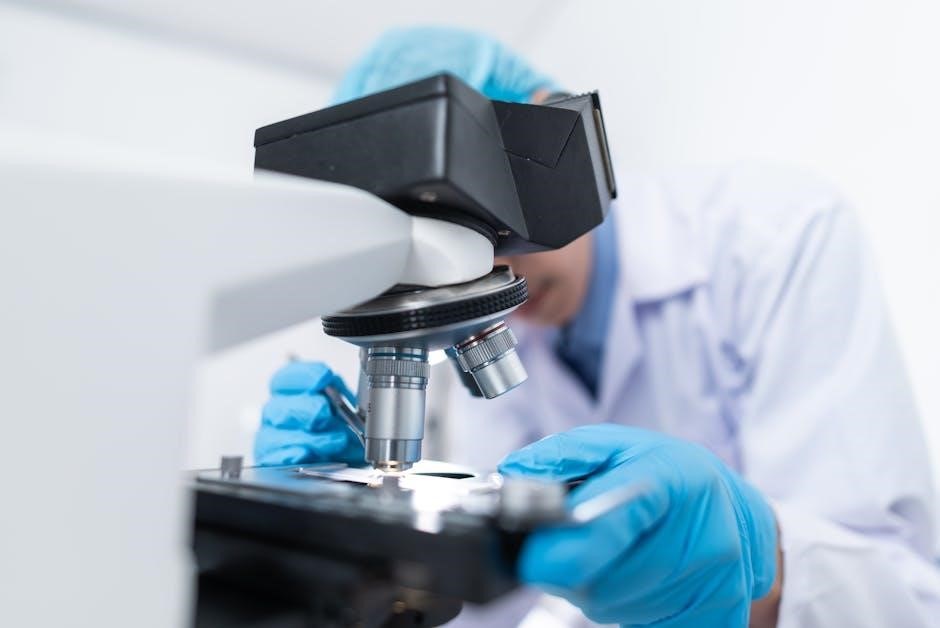
Proper waste disposal is crucial for safety and environmental compliance. Segregate waste into categories like hazardous chemicals, broken glass, and contaminated materials. Use labeled containers for each type. Dispose of hazardous chemicals according to local regulations and lab protocols. Neutralize acids and bases before disposal when possible. Broken glass must be placed in designated containers. Contaminated materials, such as gloves or paper, should be sealed in bags. Always consult the lab manual or safety guidelines for specific disposal methods. Proper disposal prevents accidents and protects the environment. Ensure all waste is handled by trained personnel and follows established safety protocols.

Common Laboratory Techniques
Common lab techniques include filtration, crystallization, and distillation. These methods ensure pure samples and accurate results. They are essential for separating and purifying substances in chemistry experiments.
4.1 Filtration and Crystallization
Filtration and crystallization are fundamental techniques in chemistry labs for separating and purifying substances. Filtration involves passing a liquid through a filter paper in a funnel, often using a Bunsen burner or vacuum pump, to isolate solids. Crystallization, meanwhile, is a method of purifying compounds by cooling a saturated solution, allowing pure crystals to form. These methods are crucial for obtaining pure samples, especially in organic chemistry. Proper techniques ensure minimal loss of material and high purity. Both processes are essential for accurate experimental results and are widely used in laboratory procedures to maintain precision and consistency.
4.2 Distillation and Separation Methods
Distillation is a key laboratory technique used to separate mixtures based on differences in boiling points. It involves heating a liquid mixture to produce vapor, which is then condensed and collected. This method is particularly useful for purifying liquids and separating components with distinct boiling points. Proper setup of the distillation apparatus is crucial to ensure safe and efficient operation. Other separation methods include chromatography and centrifugation, each tailored for specific types of mixtures. These techniques are essential for isolating pure compounds, a critical step in many chemical analyses and experiments.
4.3 Spectrophotometry and Chromatography
Spectrophotometry measures the interaction of light with substances, quantifying concentrations based on absorbance. It is widely used for analyzing solutions and determining molar concentrations. Chromatography separates mixtures into components, identifying and quantifying each. Techniques like gas chromatography (GC) and high-performance liquid chromatography (HPLC) are common. These methods are essential for purity testing and compound identification. Together, they provide precise data, enhancing the accuracy of chemical analyses and ensuring reliable results in laboratory experiments.

Acid-Base Titration Procedures
Acid-base titrations determine the concentration of acids or bases by reacting them with standard solutions. They involve preparing solutions, adding indicators, and calculating concentrations based on reaction endpoints.
5.1 Strong Acid-Strong Base Titrations
Strong acid-strong base titrations involve reacting a strong acid with a strong base to form water and a salt. For example, HCl reacts with NaOH to produce NaCl and water. The procedure includes preparing standard solutions, using a burette to measure the base, and adding an indicator like phenolphthalein to detect the endpoint. The reaction is exothermic and reaches a sharp endpoint. Calculations involve stoichiometric relationships (M1V1 = M2V2) to determine the concentration of the unknown solution. These titrations are straightforward due to complete neutralization and are commonly used in lab manuals for teaching and analysis.
5.2 Weak Acid-Strong Base Titrations
Weak acid-strong base titrations involve reacting a weak acid, like acetic acid, with a strong base, such as NaOH. The reaction proceeds gradually, requiring careful endpoint detection. Phenolphthalein is commonly used as an indicator, turning pink at the equivalence point. The burette delivers the base, and the acid is in the conical flask. Calculations involve determining the weak acid’s concentration using the normality equation (N1V1 = N2V2). Unlike strong acid-strong base titrations, these reactions do not proceed to completion immediately, making precise endpoint detection crucial. These titrations are essential for understanding buffer solutions and acid-base equilibria in lab manuals.
5.3 Back Titration Methods
Back titration is a method used to determine the concentration of a substance that does not directly react with the titrant. A known excess of a standard solution is added to the analyte, and the remaining titrant is then titrated with a second solution. This technique is particularly useful for weak acids or bases that do not react completely with the titrant. The calculation involves determining the difference between the initial and final volumes of the standard solution. Back titration is commonly used in lab manuals for analyzing substances like hydrated oxalic acid, ensuring accurate concentration determinations in chemistry experiments.
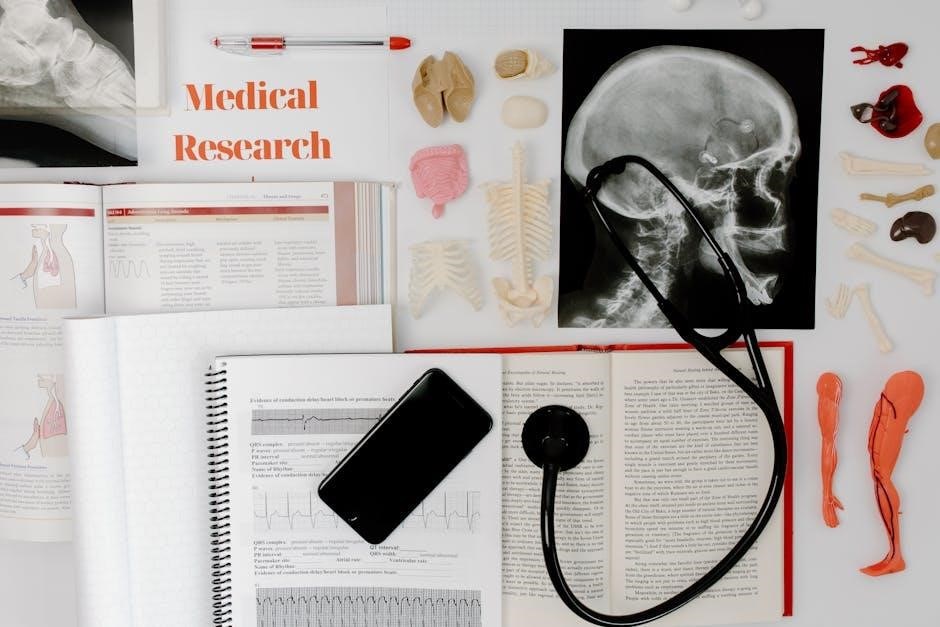
Redox Titration and Its Applications
Redox titration involves reactions where one substance is oxidized and another is reduced. It is widely used in chemistry labs for determining concentrations of oxidizing agents like potassium permanganate.
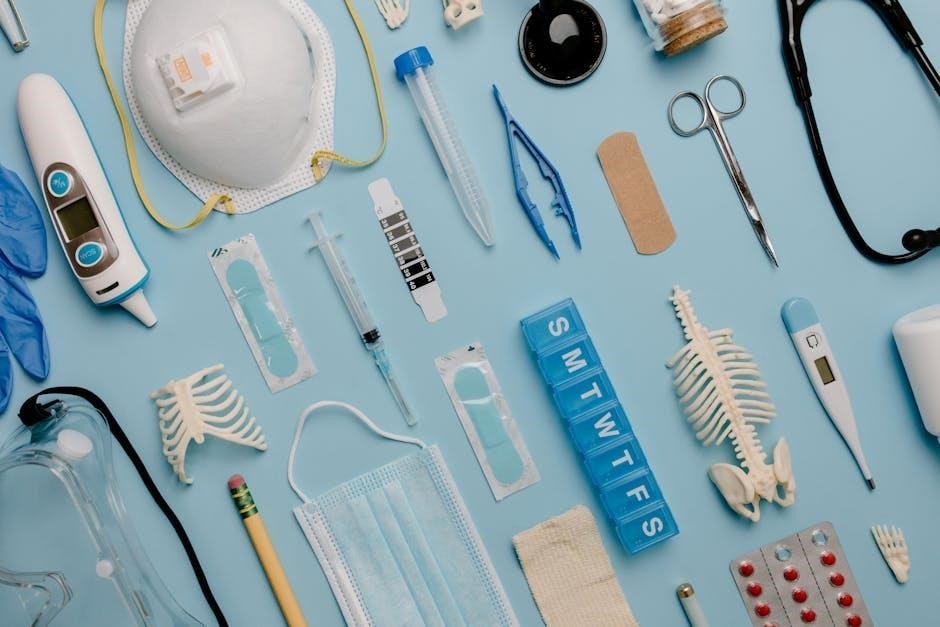
6.1 Potassium Permanganate Titrations
Potassium permanganate (KMnO₄) is a strong oxidizing agent commonly used in redox titrations. It is particularly effective in acidic conditions, where it is reduced to Mn²⁺. The titration setup involves a burette filled with KMnO₄ solution and a conical flask containing the analyte, often with sulfuric acid (H₂SO₄) to maintain acidity. Phenolphthalein is used as an indicator, turning colorless to pink at the endpoint. Students carefully record volume readings to calculate the molarity of the analyte. This method is precise for determining concentrations of reducing agents like Fe²⁺ or oxalic acid, emphasizing accurate measurement and stoichiometric calculations.
6.2 Iodine-Thiocyanate Reactions
Iodine-thiocyanate reactions are widely used in titrations to determine the concentration of iodine or thiosulfate solutions. The reaction involves iodine (I₂) reacting with sodium thiosulfate (Na₂S₂O₃) in the presence of iodine starch. The blue complex formed (I₂-starch) disappears at the endpoint, indicating the reaction is complete. This method is precise for analyzing iodine in samples and understanding redox reactions. Students learn to use burettes and volumetric flasks for accurate measurements, ensuring reliable results. The procedure reinforces stoichiometric calculations and the importance of indicators in titration processes.
6.3 Electrochemical Methods
Electrochemical methods are essential tools for studying redox reactions and electrode processes. Techniques like cyclic voltammetry and chronoamperometry are used to analyze electrode behavior, providing insights into reaction kinetics and thermodynamics. These methods involve measuring current and potential changes, offering precise data for understanding electron transfer mechanisms. In lab manuals, students learn to assemble electrochemical cells, interpret data, and apply these methods to real-world applications, such as battery testing and sensor development. Proper handling of electrodes and electrolytes is emphasized to ensure accurate and reproducible results, making electrochemical methods a cornerstone of modern analytical chemistry.
Laboratory Notebooks and Record Keeping
Laboratory notebooks are essential for documenting experiments, ensuring accuracy and reproducibility. They should include dates, objectives, procedures, observations, and results, serving as legal records of scientific work.
7.1 Setting Up a Lab Notebook
Setting up a lab notebook is crucial for organized and accurate record-keeping. Begin by labeling the notebook with your name, course, and purpose. Date each entry and include a clear objective for the experiment. Divide the notebook into sections: pre-lab research, procedures, observations, and results. Use permanent ink and avoid erasures. Include sketches, graphs, and tables as needed. Ensure all data is raw and uninterpreted. Regularly review and update entries, maintaining clarity and consistency. This notebook serves as a legal and official record of your scientific work, fostering reproducibility and accountability.
7.2 Recording Observations and Data
Accurate and systematic recording of observations and data is essential in chemistry labs. Use a lab notebook to document all measurements, readings, and phenomena observed. Record data in a clear, organized manner, avoiding interpretations. Include dates, experiment titles, and relevant details. Use bullet points or tables for clarity. Note unusual occurrences and deviations from expected results. Sketches or diagrams can supplement written observations. Ensure all entries are legible and dated. Avoid erasures; instead, draw lines through errors. This practice ensures transparency, reproducibility, and accountability, making your data reliable for analysis and reporting.
7.4 Maintaining Accuracy and Integrity
Maintaining accuracy and integrity in laboratory notebooks is crucial for reliable scientific work. Ensure all entries are truthful and free from fabrication. Record data precisely as observed, avoiding assumptions. Use correction methods like striking through errors with a single line, not erasing. Document all steps, including unexpected results, to ensure transparency. Regularly review and verify entries for consistency. Have a peer or supervisor validate critical data. Adhere to institutional guidelines and ethical standards. Accurate and honest documentation fosters trust and ensures the reproducibility of experiments, upholding the integrity of scientific inquiry and collaboration.
Error Analysis and Troubleshooting
Error analysis identifies experimental discrepancies, distinguishing systematic from random errors. Troubleshooting involves reviewing procedures, recalibrating instruments, and validating data to ensure accurate and reliable results.
8.1 Sources of Experimental Error
Experimental errors in chemistry labs often arise from inaccurate measurements, faulty calibration of instruments, or improper handling of equipment. Contamination of samples, inconsistent environmental conditions, and human error during procedures also contribute. Additionally, miscalculations, misinterpretation of data, and failure to follow protocols can introduce errors. Identifying these sources is crucial for improving experimental accuracy and reliability. By understanding and addressing these factors, students can refine their techniques and ensure more precise outcomes in future experiments.
8.2 Statistical Analysis of Results
Statistical analysis is essential for interpreting experimental data in chemistry labs. It involves calculating mean, standard deviation, and percent error to assess precision and accuracy. By comparing experimental results with theoretical values, students can evaluate the reliability of their data. Statistical tools help identify trends, inconsistencies, and sources of error. Understanding data variability and confidence intervals enhances the validity of conclusions. Proper statistical methods ensure that results are reproducible and scientifically sound, fostering a deeper understanding of chemical principles and experimental design.
8.3 Common Mistakes and Solutions
Common mistakes in chemistry labs include improper use of PPE, inaccurate measurements, and deviations from procedures. Solutions involve strict adherence to SOPs, double-checking measurements, and proper waste disposal. Students should ensure all equipment is calibrated and understand the experiment’s objective before starting. Regularly reviewing lab manuals and seeking guidance from instructors can minimize errors. Maintaining a clean workspace and labeling substances correctly prevent accidents. Attention to detail and thorough preparation are key to avoiding mistakes and ensuring safe, successful experiments.

Laboratory Reports and Presentations
Laboratory reports and presentations are essential for communicating experimental results. They include clear objectives, methods, results, and conclusions, ensuring data is accurately interpreted and properly referenced.
9.1 Structure of a Lab Report
A well-structured lab report includes a title, introduction, materials, procedure, results, discussion, and references. The title briefly describes the experiment. The introduction outlines objectives and background. Materials list equipment and chemicals. The procedure details steps taken. Results present data without interpretation. The discussion analyzes findings, compares with theory, and draws conclusions. References cite sources used. Clear and concise language ensures readability. Proper formatting and organization are essential for academic and professional standards. Each section serves a specific purpose, ensuring the report is comprehensive and informative.
9.2 Data Interpretation and Discussion
Data interpretation involves analyzing experimental results to draw meaningful conclusions. This section compares observed data with theoretical values, identifying trends or discrepancies. Discussions explain the significance of findings, linking them to the experiment’s objectives. Error analysis highlights potential sources of inaccuracy, while statistical methods validate results. Clear interpretation helps assess the experiment’s success and understand underlying chemical principles. Effective discussion sections also suggest improvements or future experiments, demonstrating a deep understanding of the subject matter. This step is crucial for connecting raw data to broader scientific concepts and ensuring the experiment’s relevance and reliability.
9.3 Effective Presentation Techniques
Effective presentation techniques are crucial for conveying experimental results clearly. Use clear headings, bullet points, and visuals like graphs or images to enhance understanding. Summarize key findings concisely, avoiding unnecessary details. Practice your delivery to ensure smooth pacing and confidence. Engage the audience with relevant questions or discussions. Properly cite sources and acknowledge contributions. Use handouts or digital tools to provide quick references. Ensure consistency in formatting and terminology. Focus on highlighting the significance of your work and its implications. These strategies help communicate complex data effectively, making your presentation informative and impactful for both peers and instructors.
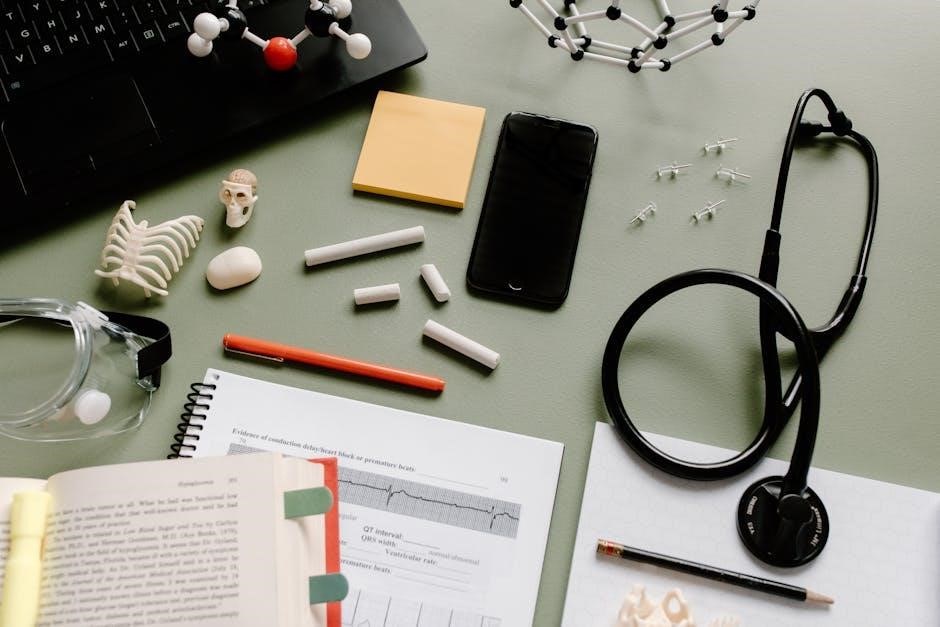
Advanced Laboratory Techniques
Advanced techniques like chromatography, spectroscopy, and electrochemistry enhance precision in chemical analysis. These methods enable detailed study of molecular structures and reactions, advancing research in materials science and nanotechnology.
10.1 Chromatography and Spectroscopy
Chromatography separates chemical mixtures based on differential partitioning between phases, aiding in component identification and purification. Spectroscopy analyzes molecular structures by measuring interactions with electromagnetic radiation, providing insights into chemical bonding and composition. These techniques are essential in modern chemistry for qualitative and quantitative analysis, enabling researchers to study complex systems and verify experimental results accurately. They are widely applied in pharmaceuticals, environmental monitoring, and materials science, ensuring high precision and reliability in laboratory investigations.
10.2 Electrochemistry and Electrodes
Electrochemistry involves the study of chemical reactions driven by electrical energy, focusing on redox reactions at electrode surfaces. Electrodes, conductive materials, facilitate electron transfer, enabling processes like electrolysis and battery operation. Types include working, reference, and counter electrodes, each serving specific roles in electrochemical cells. Proper electrode maintenance and calibration are crucial for accurate measurements. Applications span energy storage, sensors, and corrosion studies, making electrochemistry integral to advancing technologies. Lab manuals detail standard operating procedures for electrode handling, ensuring safety and precision in experimental setups. Understanding electrochemistry is vital for innovations in renewable energy and medical diagnostics.
10.3 Nanofabrication and Cleanroom Practices
Nanofabrication involves creating nano-scale structures using advanced techniques like lithography, etching, and deposition. Cleanroom practices are essential to minimize contamination, ensuring precise control over nanoscale processes. Lab manuals detail SOPs for cleanroom entry, gowning, and tool operation. Proper handling of hazardous chemicals and waste disposal are emphasized. Techniques like electron beam lithography and atomic layer deposition require meticulous calibration. Safety protocols, including personal protective equipment, are critical. These practices are vital for producing high-quality nanostructures, enabling advancements in electronics, optics, and biomedicine. The lab manual provides step-by-step guidance, ensuring reproducibility and safety in nanofabrication processes.
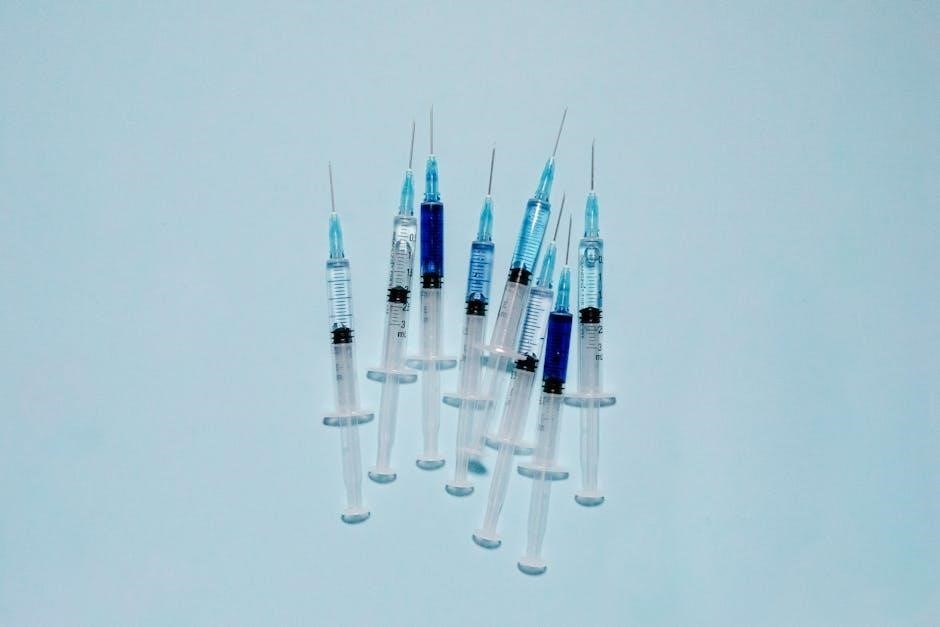
Resources and References
Key resources include NCERT lab manuals, online tools, and safety guidelines. These provide detailed procedures, theoretical insights, and practical tips for chemistry experiments, ensuring safe and accurate results.
11.1 Recommended Lab Manuals
Recommended lab manuals include NCERT Chemistry Lab Manuals, which emphasize practical skills and theoretical understanding. Chemistry in Context offers real-world applications, while Flinn Scientific provides comprehensive kits and guides. These manuals align with educational standards, ensuring experiments are safe and educational. They cover essential techniques, data analysis, and safety protocols, making them invaluable for students and educators. Digital versions are also available, enhancing accessibility. These resources are regularly updated to reflect advancements in chemistry, ensuring learners stay current with modern practices and methodologies.
11.2 Online Tools and Tutorials
Online tools and tutorials enhance chemistry lab learning, offering interactive guides and videos. Platforms like Flinn Scientific provide digital lab manuals and experiment simulations. YouTube channels feature step-by-step tutorials for techniques like glassware handling and chemical preparation. Websites such as Khan Academy and Coursera offer courses with lab-focused modules. Additionally, many universities share lab guides and safety protocols online. These resources help students master procedures, interpret data, and understand safety measures. They also include quizzes and assessments to test knowledge. Online tools are invaluable for both classroom preparation and independent study, ensuring a strong foundation in chemistry lab practices.
11.3 Safety Guidelines and Regulations
Safety guidelines and regulations are crucial in chemistry labs to prevent accidents and ensure compliance with legal standards. Labs must adhere to OSHA regulations and local safety protocols. Key elements include proper use of PPE, handling of hazardous chemicals, and emergency procedures. Students and staff must be trained on safety practices, such as reading SDSs and managing chemical spills. Regular inspections and safety audits are conducted to enforce compliance. Violations of safety rules can lead to disciplinary actions. These guidelines protect individuals and the environment, ensuring a safe and responsible laboratory environment for all participants.
